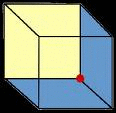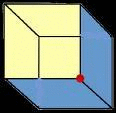

An optical illusion
When observing a rotating Jmol model , one normally perceives very clearly the sense of rotation as clockwise or counterclockwise. It happens quite often that two persons simultaneously watching the same revolving object on the same screen realize (with astonishment) that they do not agree with each other on the sense of the rotation they are observing.
More than that , the same person , having observed closely a revolving model may suddenly experience that same kind of reversal in the perceived sense of rotation.
Such observations are usually attributed to the operation of the software controlling the presentation or are dismissed with disbelief etc .
While Jmol ,like most other viewers, can display oscillatory movements with regular reversal of rotation, the reversal we mentioned above has nothing to do with the program itself or the display screen frame rate etc, but is simply a reversal of perception of movement and is classified as an optical illusion.
The visual data from the retina of the eye are processed by the appropriate centers of the brain and are given a “meaning” ,that is they are interpreted in a manner that best fits previously established patterns. The changes of relative lengths and angles of the lines constituting an image, are understood as movement towards or away from the observer.
Some times it happens that these visual cues can be interpreted equally well in two conflicting ways as is the case with the famous Necker cube where there are insufficient data for the brain to decide unambiguously which side of the cube is in front and which is behind. Since the image “must be understood “ somehow , the decision is "forced" arbitrarily, but it can easily be reversed at a second glance!
The Necker Cube.
Do you see the red dot at the front? Then your assumption is that you are looking at the cube from below-right.
Do you see the
red dot at the back? Then your assumption is
that you are looking at the cube from above-left.
In the image to
the right , part of the edge lines has been erased as you can observe. The
assumptions in this case are the following:
there should be lines
continuing there but I do not see them ,therefore there is a face of the cube
between the lines and myself
obstructing the view .I have then to conclude that the face defined by those
lines is also in the rear part of the object (cube ). which helps to
imagine the red dot at the front.
So, it happens that on occasion we are capable of seeing
just what we are willing to see! The implications are very serious as one can
easily imagine ,starting in everyday's life and reaching as far as philosophy.
In so far as Chemistry is concerned and particularly
stereochemistry
such visual phenomena are again present and although we take care to give our
eyes good assistance (through the various conventions of drawing with wedged
bonds and perspective views etc ) it still requires some training to come to
imagine what is near and what is far
in the molecular
structures we are dealing with.
More about optical illusions can be found in the well documented site of M. Bach. http://www.michaelbach.de/ot/